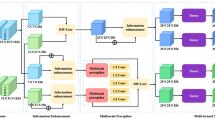Abstract
Long time tracking in video stream is one of the most challenging problem in computer vision. Most state-of-the-art visual trackers rely on the classical sliding windows, resulting in a large number of candidate object window. In order to achieve purpose of real-time tracking, the weak feature is used for object description. So in many complex scenes, such as illumination variation, the algorithm performance is seriously decreased. Firstly, a more efficient object detection algorithm called BIN-NST is used to improve the detector in the tracking–learning–detection framework. We find that the normed gradients, designed for generic objectness estimation, are also able to rapidly generate high quality candidate windows. We also notice that using the tensor feature to replace the gradients feature can improve the performance of objectness estimation. Based on these observations, we propose an efficient method, which we call BIN-NST, to produce candidate windows. Experiments on the challenging PASCAL VOC 2007 dataset show that our method efficiently generates a small set of category-independent, high quality object windows. The performance of BIN-NST and BING is almost the same in the single scene, but the performance of BIN-NST in the complex scene is significantly higher than that of the BING. In addition, compared to the classical sliding windows mechanism used in the tracking–learning–detection framework, the candidate window generated by BIN-NST is reduced by about 90%. Secondly, GOTURN tracker is a method for offline training of neural networks that can track novel objects at test-time at 100 fps. The GOTURN tracker is significantly faster than previous methods that use neural networks for tracking. But the GOTURN tracker will fail to track object when the object become occluded and is moving too quickly. In this paper, these candidate object windows, which are detected by object detector based on BIN-NST, are fed to the network of GOTURN. The object extraction ability of the detector is used to solve the problem that the GOTURN algorithm cannot track fast moving object effectively. The experiment shows that the tracking algorithm can still track the object effectively when the object is moving quickly.





Similar content being viewed by others
References
Alexe B, Deselaers T, Ferrari V (2012) Measuring the objectness of image windows. IEEE TPAMI 34(11):2189–2202
Azimi I, Rahmani AM, Liljeberg P et al (2017) Internet of things for remote elderly monitoring: a study from user-centered perspective. J Ambient Intell Humaniz Comput 8(2):1–17
Babenko B, Yang MH, Belongie S (2011) Robust object tracking with online multiple instance learning. IEEE Trans Pattern Anal Mach Intell 33(8):1619–1632
Bigun J, Granlund GH, Wiklund J (1991) Multidimensional orientation estimation with applications to texture analysis and optical flow. IEEE Trans Pattern Anal Mach Intell 13(8):775–790
Brox T, Ro usson M et al (2010) Color, texture and motion in level set based segmentation and tracking. Image Vis Comput 28(3):376–390
Calvaresi D, Cesarini D, Sernani P et al (2017) Exploring the ambient assisted living domain: a systematic review. J Ambient Intell Humaniz Comput 8(2):239–257
Camacho D, Novais P (2017) Innovations and practical applications of intelligent systems in ambient intelligence and humanized computing. J Ambient Intell Humaniz Comput 8(2):155–156
Everingham M, Gool LV, Williams CKI et al (2010) The Pascal visual object classes (VOC) challenge. Int J Comput Vis 88(2):303–338
Gallego FB (2016) On problems of topological dynamics in non-autonomous discrete systems. Appl Math Nonlinear Sci 1:391–404
Gracia JD, Fernández JMP (2016) Monotonicity preserving representations of curves and surfaces. Appl Math Nonlinear Sci 1(2):517–528
Hare S, Saffari A, Torr P (2015) Struck: structured output tracking with kernels. ICCV 38(10):2096–2109
Isard M, Blake A (1998) Condensation—conditional density propagation for visual tracking. Int J Comput Vis 29(1):5–28
Kalal Z, Mikolajczyk K, Matas J (2012) Tracking–learning–detection. IEEE Trans Pattern Anal Mach Intell 34(7):1409–1422
Perona P, Malik J (1990) Scale space and edge detection using anisotropic diffusion. IEEE Trans Pattern Anal Mach Intell 12(7):629–639
Smeulders AWM, Chu DM, Cucchiara R et al (2014) Visual tracking: an experimental survey. IEEE Trans Pattern Anal Mach Intell 36(7):1442–1468
Author information
Authors and Affiliations
Corresponding author
Additional information
Publisher’s Note
Springer Nature remains neutral with regard to jurisdictional claims in published maps and institutional affiliations.
Rights and permissions
About this article
Cite this article
Li, X., Wang, T. A long time tracking with BIN-NST and DRN. J Ambient Intell Human Comput 11, 4321–4327 (2020). https://doi.org/10.1007/s12652-018-1025-7
Received:
Accepted:
Published:
Issue Date:
DOI: https://doi.org/10.1007/s12652-018-1025-7




